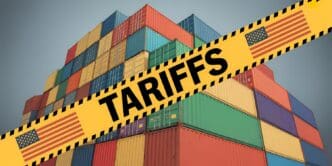Executive Summary
The Story So Far
Why This Matters
Who Thinks What?
President Donald Trump’s administration’s sweeping tariffs, intended to create jobs and boost the American economy, are reportedly prompting global food and drink exporters to pivot towards markets like China. Experts and industry figures suggest these levies, which include a 50% import tax on Brazilian coffee and various duties on Indian goods, could lead to higher prices for American consumers and push international suppliers to diversify away from the U.S. market.
Exporters Shift Towards China
Brazilian coffee exporters, facing a significant 50% U.S. import tax, are increasingly viewing China as a viable alternative market. Agricultural brokers have observed a surge in interest for trade with China from global exporters.
Supply chain specialist Hugo Portes noted that China’s expanding cafe culture and large market have made it “a shining light” for Brazilian coffee. He suggested that tariffs intended to weaken Brazil are, in reality, drawing sellers closer to China.
In July, over 180 Brazilian coffee firms registered to export to China, a move described as “unprecedented” by Mr. Portes. This follows a billion-dollar deal signed last year between Brazilian coffee producers and Luckin Coffee, a major Chinese chain.
Fernanda Pizol of Daterra Coffee confirmed plans to increase sales to China, Japan, and Europe if U.S. demand diminishes. She stated that many American buyers have paused orders to assess the tariffs’ impact, while business with Chinese buyers has already grown significantly.
Indian Producers Seek New Markets
Similarly, Indian exporters of goods such as tea and seafood, affected by tariffs including a 50% levy, are exploring opportunities in China and Europe. The South Asian nation also faces a 25% penalty for buying Russian oil, alongside another 25% tariff on Indian goods, which Delhi has called “unreasonable.”
K.N. Raghavan of the Seafood Exporters Association of India noted that many U.S. buyers have paused new prawn orders. He is optimistic about ongoing trade talks with Washington but anticipates that Indian producers will increase sales to China, their second-largest seafood export market.
Mohit Agarwal from Asian Tea and Exports identified China as the top alternative market for his firm. He expressed concern, however, that Indian exporters might face competition from African producers offering similar quality at lower prices.
Potential Costs for U.S. Consumers
For American consumers, these tariffs are projected to lead to increased costs. Coffee consultant Luke Waite estimated that a five-pound bag of Brazilian beans could rise by approximately 25%, potentially increasing the cost per cup of coffee by up to 7%.
Some American businesses are struggling to adapt, arguing that domestic production of goods like coffee and prawns is impractical. A major U.S. seafood trade association, for instance, has requested a tariff exemption due to the market’s reliance on imports and concerns about overfished American waters.
Grocery retail giant Walmart has warned of potential price increases, stating that while it has absorbed higher costs thus far, it expects them to continue rising. Many analysts and industry players anticipate that at least a portion of President Trump’s tariffs will be passed on to American consumers.
Abuthahir Aboobakar, sales director of Jeelani Marine Products, noted that many U.S. customers have continued to place orders despite tariffs, suggesting American consumers are likely to bear the costs. He added that his firm plans to diversify, with China and Europe gaining a larger share of its exports.
In summary, President Trump’s tariffs are prompting a significant reorientation of global trade flows, particularly for agricultural and seafood exporters. While intended to benefit the U.S. economy, these measures appear to be driving international suppliers towards alternative markets and could result in higher prices for American consumers, underscoring the complex and often counterintuitive effects of protectionist trade policies.








